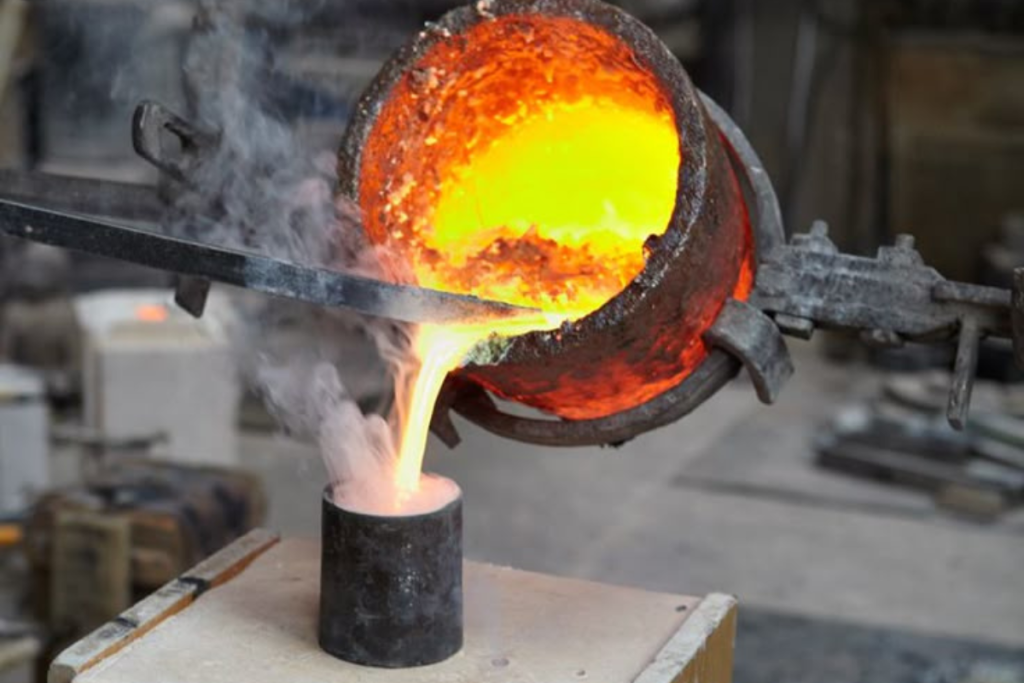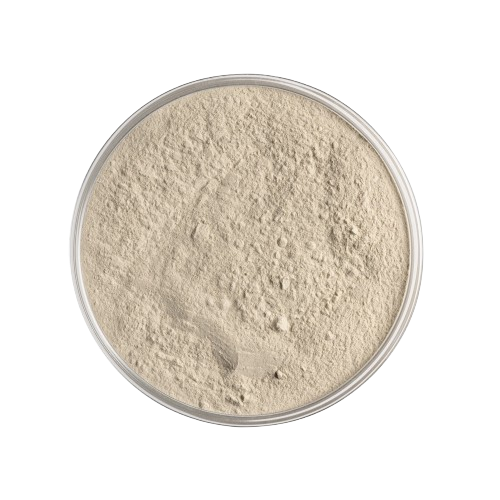Foundry Bentonite
- Provides excellent green sand binding strength
- Ensures superior mold stability and durability
- Improves sand permeability for gas release
- Enhances thermal stability during metal casting
- Maintains consistent performance in foundry applications
Download :

Foundry bentonite is a high‐purity, swelling clay (mostly montmorillonite) used as the casting clay binder in sand molds for metal casting. It forms when volcanic ash or tuff undergoes devitrification and alteration (typically in marine environments). The montmorillonite in bentonite is an aluminum phyllosilicate with microscopic platelets that hold exchangeable sodium (Na⁺) or calcium (Ca²⁺) ions. These platelets readily absorb water and swell (up to ~8× their dry volume), giving bentonite its unique ability to bind sand grains into a cohesive, plastic mold. As an industrial clay binder, foundry bentonite is prized for its high surface area, plasticity, and thermal stability.

Sodium vs. Calcium Bentonite for Foundry Use
Sodium bentonite has a much greater swelling capacity than calcium bentonite . This high swell and plasticity makes sodium bentonite especially valued in foundry green sand for producing strong, fine-grained molds. Calcium bentonite (sometimes called “southern” bentonite) is non‑swelling or low‑swelling and often gives slightly higher initial green compression strength and better sand flowability
Role in Metal Casting (Green Sand Molds)
In metal casting, bentonite’s primary role is as the binder in green sand molding. A typical green-sand mixture is ~85–95% high-purity silica sand, 5–10% bentonite clay, plus about 2–5% water (and often ≤5% carbonaceous additives like coal dust). When moistened and rammed around a pattern, the bentonite coats sand grains and interlocks via its swollen platelets.. This gives the mold its green (wet) strength and plasticity. Crucially, bentonite binds the sand without chemical curing: its cohesion comes solely from water-induced swelling and surface charge attraction.
In practice, foundry bentonite produces molds with excellent green compression and tensile strength, so that the mold holds shape during handling and metal pour. It also imparts thermal stability – the clay remains cohesive even as the molten metal (often exceeding 1000°C) heats the mold. Bentonite-containing sand has sufficient permeability and collapsibility to vent gases while withstanding the heat. The plasticity of bentonite ensures good detail reproduction and a relatively smooth casting surface.
Bentonite’s properties in the mix (swelling index, plasticity, clay content) directly affect mold quality. High-quality foundry bentonite yields molds that resist cracking, allow easy shakeout of the casting, and can be reclaimed and reused in multiple cycles.
Comparison with Alternative Binder Systems
Although bentonite clay is the traditional binder for green sand, foundries also use other systems. The table below compares bentonite with common alternatives: sodium silicate (water glass), synthetic resin binders, and simple organic binders.
| Binder Type | Thermal Stability | Reusability (Sand Reclaim) | Cost | Environmental/Safety |
|---|---|---|---|---|
| Bentonite (clay) | Very high (inorganic; remains as clay under heat); no binder burnout needed. | Very good – used sand can be reconditioned with water; bentonite causes minimal fouling. | Low (natural mineral). | Inert, non-toxic, low dust hazard. Requires no hazardous curing chemicals. |
| Waterglass (Na₂SiO₃) | Moderate – glass network stable, but molds are rigid and can crack on heating. | Moderate to poor – requires recoating with water/acid or heat to break bonds; sand is more fragile during shakeout. | Medium – chemical manufacturing cost. | Non-toxic but highly alkaline; no organic fumes. Disposal requires neutralization. |
| Phenolic/Furan Resins (synthetic) | Low – organic polymers break down (~200–500 °C), leaving carbonaceous char. | Low – cured resin sticks strongly to sand, making reclamation difficult. | High–resins and catalysts are costly. | Produces toxic fumes (phenol, formaldehyde, SO₂) when heated. Requires ventilation. |
| Organic (dextrin/molasses) | Very low – burns out completely, leaving no residue. | Good – burnt sand can be reused; binder burns to CO₂/H₂O. | Low – inexpensive, food-grade materials. | Generally safe/biodegradable, though dust and sugars can support microbial growth. |
The table highlights that foundry bentonite offers superior high-temperature stability and ease of sand reuse at low cost, with minimal environmental hazard. In contrast, synthetic resin binders give the highest green strength and precision but generate hazardous emissions and complicate sand regeneration. Waterglass cures rapidly at room temperature, but its very high strength can cause hot tearing and poor collapse. Organic binders (like dextrin or molasses) are cheap and burn out cleanly, but they yield much weaker molds and are mainly used for cores or specialty processes.
Sourcing and Quality Considerations for Importers

PH | 8 - 10 % |
Odor | Odorless |
Dry Compression Strength | 600-750 kPa |
Green Compression Strength | 145-165 kPa |
Montmorillonite | ≥ 85% |
Particle Size | ≥ 90% passing 200 mesh |
Moisture | Max 10% |
Mold Hardness | 88-95 |

Historical Development of Bentonite in the Foundry Industry
The utilization of bentonite in metal casting dates back to the 1920s, coinciding with the automotive industry’s mass production requirements. In 1931, Ford Motor Company pioneered the systematic implementation of sodium bentonite in automotive production lines, revolutionizing mold preparation techniques.
Technical Inquiries and Scientific Responses
1. Bonding Mechanism in Green Sand Systems
Bentonite operates through a dual mechanism:
Vander Waals forces between montmorillonite layers and silica particles
Formation of water bridges between sand grains
Development of a colloidal structure providing green and dry strength
2. Impact of Impurities on Performance
Calcium carbonate: Reduces swelling capacity and strength
Pyrite: Causes gas defects and pinholes
Quartz: Decreases plasticity and increases equipment wear
3. Advanced Analytical Techniques
X-ray Diffraction (XRD) for montmorillonite quantification
Brunauer-Emmett-Teller (BET) for surface area measurement
Differential Thermal Analysis (DTA/TGA) for thermal behavior
Scanning Electron Microscopy (SEM) for morphological study
4. Challenges in Alloy Steel Casting Applications
Thermal degradation above 1600°C
Interaction with alloying elements (Cr, Mn)
Complex slag formation
5. Recent Technological Advancements
Nano-modification with organic polymers
Mechano-chemical activation
Integration with synthetic nano-clays
Table 1: Comparative Performance of Bentonite Types at Elevated Temperatures
| Bentonite Type | Optimal Temp Range (°C) | Maximum Thermal Resistance (°C) | Strength Loss at 1000°C |
|---|---|---|---|
| Natural Sodium | 100-300 | 1200 | 25-30% |
| Activated Calcium | 80-250 | 1000 | 40-50% |
| Hybrid Formulations | 150-400 | 1350 | 15-20% |
Table 2: Effect of Modern Additives on Bentonite Properties
| Additive | Optimal Percentage | Green Strength Enhancement | Impermeability Improvement |
|---|---|---|---|
| Nano-silica | 0.5-1% | +20% | +15% |
| Polyacrylamide | 0.1-0.3% | +15% | -5% |
| Graphene Oxide | 0.01-0.05% | +30% | +25% |
Research Trends and Future Perspectives
Development of smart bentonites with thermal responsiveness
AI-driven optimization of sand formulations
Complete bentonite reclamation from spent sand
Sustainable alternatives to conventional bentonite



